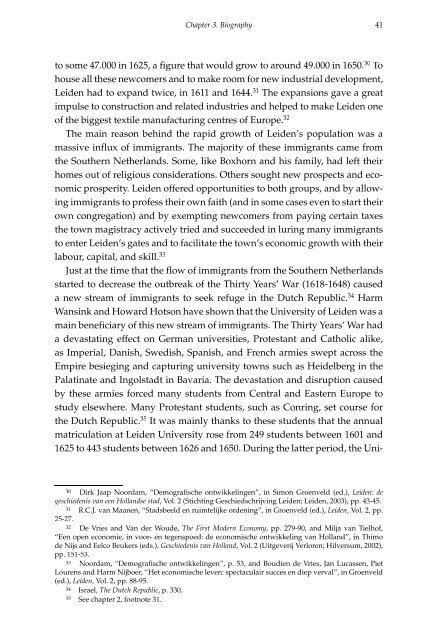historical and political thought in the seventeenth - RePub - Erasmus ...
historical and political thought in the seventeenth - RePub - Erasmus ...
historical and political thought in the seventeenth - RePub - Erasmus ...
Create successful ePaper yourself
Turn your PDF publications into a flip-book with our unique Google optimized e-Paper software.
Chapter 3. Biography<br />
to some 47.000 <strong>in</strong> 1625, a figure that would grow to around 49.000 <strong>in</strong> 1650. 30 To<br />
house all <strong>the</strong>se newcomers <strong>and</strong> to make room for new <strong>in</strong>dustrial development,<br />
Leiden had to exp<strong>and</strong> twice, <strong>in</strong> 1611 <strong>and</strong> 1644. 31 The expansions gave a great<br />
impulse to construction <strong>and</strong> related <strong>in</strong>dustries <strong>and</strong> helped to make Leiden one<br />
of <strong>the</strong> biggest textile manufactur<strong>in</strong>g centres of Europe. 32<br />
The ma<strong>in</strong> reason beh<strong>in</strong>d <strong>the</strong> rapid growth of Leiden’s population was a<br />
massive <strong>in</strong>flux of immigrants. The majority of <strong>the</strong>se immigrants came from<br />
<strong>the</strong> Sou<strong>the</strong>rn Ne<strong>the</strong>rl<strong>and</strong>s. Some, like Boxhorn <strong>and</strong> his family, had left <strong>the</strong>ir<br />
homes out of religious considerations. O<strong>the</strong>rs sought new prospects <strong>and</strong> economic<br />
prosperity. Leiden offered opportunities to both groups, <strong>and</strong> by allow<strong>in</strong>g<br />
immigrants to profess <strong>the</strong>ir own faith (<strong>and</strong> <strong>in</strong> some cases even to start <strong>the</strong>ir<br />
own congregation) <strong>and</strong> by exempt<strong>in</strong>g newcomers from pay<strong>in</strong>g certa<strong>in</strong> taxes<br />
<strong>the</strong> town magistracy actively tried <strong>and</strong> succeeded <strong>in</strong> lur<strong>in</strong>g many immigrants<br />
to enter Leiden’s gates <strong>and</strong> to facilitate <strong>the</strong> town’s economic growth with <strong>the</strong>ir<br />
labour, capital, <strong>and</strong> skill. 33<br />
Just at <strong>the</strong> time that <strong>the</strong> flow of immigrants from <strong>the</strong> Sou<strong>the</strong>rn Ne<strong>the</strong>rl<strong>and</strong>s<br />
started to decrease <strong>the</strong> outbreak of <strong>the</strong> Thirty Years’ War (1618-1648) caused<br />
a new stream of immigrants to seek refuge <strong>in</strong> <strong>the</strong> Dutch Republic. 34 Harm<br />
Wans<strong>in</strong>k <strong>and</strong> Howard Hotson have shown that <strong>the</strong> University of Leiden was a<br />
ma<strong>in</strong> beneficiary of this new stream of immigrants. The Thirty Years’ War had<br />
a devastat<strong>in</strong>g effect on German universities, Protestant <strong>and</strong> Catholic alike,<br />
as Imperial, Danish, Swedish, Spanish, <strong>and</strong> French armies swept across <strong>the</strong><br />
Empire besieg<strong>in</strong>g <strong>and</strong> captur<strong>in</strong>g university towns such as Heidelberg <strong>in</strong> <strong>the</strong><br />
Palat<strong>in</strong>ate <strong>and</strong> Ingolstadt <strong>in</strong> Bavaria. The devastation <strong>and</strong> disruption caused<br />
by <strong>the</strong>se armies forced many students from Central <strong>and</strong> Eastern Europe to<br />
study elsewhere. Many Protestant students, such as Conr<strong>in</strong>g, set course for<br />
<strong>the</strong> Dutch Republic. 35 It was ma<strong>in</strong>ly thanks to <strong>the</strong>se students that <strong>the</strong> annual<br />
matriculation at Leiden University rose from 249 students between 1601 <strong>and</strong><br />
1625 to 443 students between 1626 <strong>and</strong> 1650. Dur<strong>in</strong>g <strong>the</strong> latter period, <strong>the</strong> Uni-<br />
30 Dirk Jaap Noordam, “Demografische ontwikkel<strong>in</strong>gen”, <strong>in</strong> Simon Groenveld (ed.), Leiden: de<br />
geschiedenis van een Holl<strong>and</strong>se stad, Vol. 2 (Sticht<strong>in</strong>g Geschiedschrijv<strong>in</strong>g Leiden; Leiden, 2003), pp. 43-45.<br />
31 R.C.J. van Maanen, “Stadsbeeld en ruimtelijke orden<strong>in</strong>g”, <strong>in</strong> Groenveld (ed.), Leiden, Vol. 2, pp.<br />
25-27.<br />
32 De Vries <strong>and</strong> Van der Woude, The First Modern Economy, pp. 279-90, <strong>and</strong> Milja van Tielhof,<br />
“Een open economie, <strong>in</strong> voor- en tegenspoed: de economische ontwikkel<strong>in</strong>g van Holl<strong>and</strong>”, <strong>in</strong> Thimo<br />
de Nijs <strong>and</strong> Eelco Beukers (eds.), Geschiedenis van Holl<strong>and</strong>, Vol. 2 (Uitgeverij Verloren; Hilversum, 2002),<br />
pp. 151-53.<br />
33 Noordam, “Demografische ontwikkel<strong>in</strong>gen”, p. 53, <strong>and</strong> Boudien de Vries, Jan Lucassen, Piet<br />
Lourens <strong>and</strong> Harm Nijboer, “Het economische leven: spectaculair succes en diep verval”, <strong>in</strong> Groenveld<br />
(ed.), Leiden, Vol. 2, pp. 88-95.<br />
34 Israel, The Dutch Republic, p. 330.<br />
35 See chapter 2, footnote 31.<br />
41

















